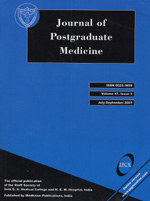
|
Journal of Postgraduate Medicine
Medknow Publications and Staff Society of Seth GS Medical College and KEM Hospital, Mumbai, India
ISSN: 0022-3859
EISSN: 0022-3859
Vol. 53, No. 4, 2007, pp. 228-231
|
 Bioline Code: jp07082
Bioline Code: jp07082
Full paper language: English
Document type: Research Article
Document available free of charge
|
|
|
Journal of Postgraduate Medicine, Vol. 53, No. 4, 2007, pp. 228-231
| en |
Miliary tuberculosis in human immunodeficiency virus infected patients not on antiretroviral therapy: Clinical profile and response to shortcourse chemotherapy
Swaminathan, S.; Padmapriyadarsini, C.; Ponnuraja, C.; Sumathi, C.H.; Rajasekaran, S.; Amerandran, V.A.; Reddy, M.V.K. & Deivanayagam, CN
Abstract
Background: An increase in tuberculosis (TB) incidence has been associated with human immunodeficiency virus (HIV).
Aims: To describe the clinical characteristics and treatment outcome of patients with HIV and miliary TB treated with short-course intermittent chemotherapy in the absence of access to highly active antiretroviral therapy (HAART).
Settings and Design: Prospective study of HIV infected adults referred to a TB clinic between July 1999 and July 2004.
Materials and Methods: On diagnosis of miliary TB, patients were treated with a standard regimen of two months of isoniazid, rifampicin, ethambutol and pyrazinamide followed by four months of isoniazid and rifampicin (2EHRZ3 /4RH3 ) thrice weekly and followed up for 24 months. Patients were reviewed clinically every month and two sputa were collected. Chest radiographs and blood investigations were done at two months, end of treatment and every six months thereafter. Results: Of 498 patients with HIV and tuberculosis, 31 (6%) were diagnosed as miliary tuberculosis. At diagnosis, sputum smear was positive for acid-fast bacilli (AFB) in 14 patients (45%) and was isolated in 21 (68%). The mean CD4 cell count was 129 ± 125 cells/mm 3 . Twenty-five patients were declared cured at the end of treatment (81%) while one (3%) died and five (16%) failed. The recurrence rate was 19.4/100 person-years and the median survival was 17 months (95% CI 14 to 20). None of the patients received antiretroviral therapy.
Conclusions: Miliary TB tends to occur among HIV infected patients with severe immunosuppression. Though the initial response to short-course chemotherapy was encouraging, a high recurrence rate and mortality was observed indicating poor prognosis in HIV.
Keywords
Human immunodeficiency virus, miliary tuberculosis, short-course chemotherapy
|
| |
© Copyright 2007 Journal of Postgraduate Medicine.
Alternative site location: http://www.jpgmonline.com
|
|
